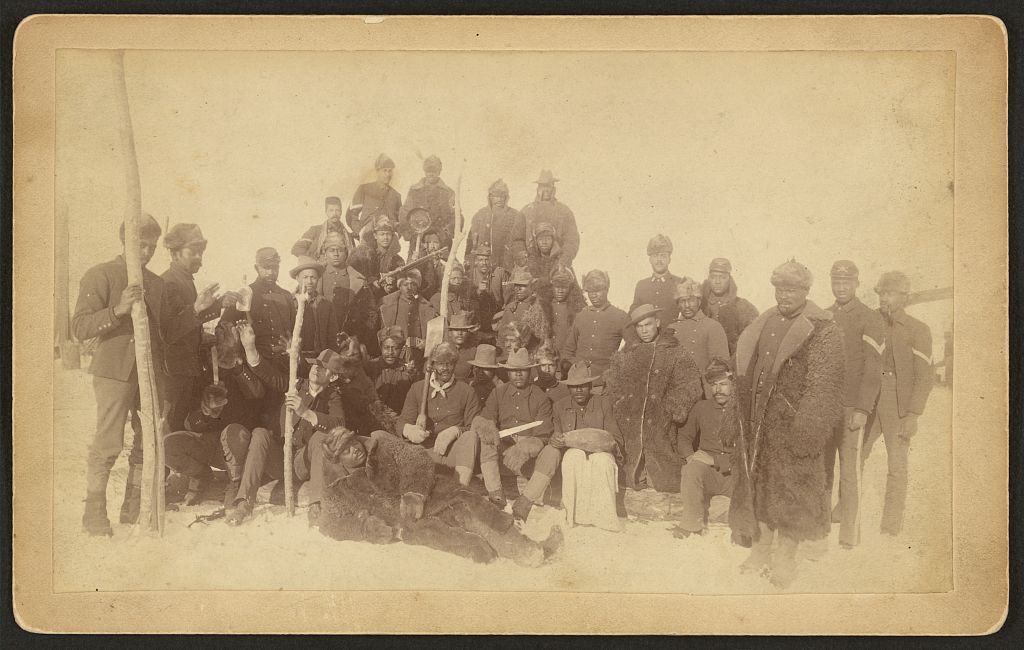Buffalo Soldiers: Twenty-fourth & Twenty-fifth Infantries
By Sofie Barrett
The Twenty-fourth and Twenty-fifth Infantry formed from the consolidation of four African American infantry regiments originally commissioned by Congress on July 28, 1866. After Congress reduced the size of the US Regular Army on March 3, 1869, personnel from the Thirty-eight, the Thirty-ninth, the Fortieth and Forty-first Infantry regiments combined to become the Twenty-fourth and Twenty-fifth.
The Twenty-fourth Infantry formed from the consolidation of the former Thirty-eighth and Forty-first Infantry redesigned on March 15, 1869. The Forty-first previously organized on December 25, 1866 in Baton Rouge, Louisiana, and served in Louisiana and Texas. The Thirty-eighth previously organized on October 1, 1866 at Jefferson Barracks, Missouri, and served in the New Mexico Territory providing security for the construction of the transcontinental railroads in the Southwest. After forming, the Twenty-fourth Infantry served in the Southwest over the next few decades maintaining and protecting peace in the Western Frontier. In addition to battles, the duties of these men involved building roads, guarding stage stations, constructing and repairing telegraph lines, guarding waterholes, and escorting supply trains. Additionally, the Twenty-fourth performed scouting patrols.
The Twenty-fifth Infantry formed from the consolidation of the former Thirty-ninth and Fortieth Infantry reorganized in April of 1868 at Jackson Barracks, Louisiana. These enlisted men came mostly from northern Virginia and southern Louisiana, many seasoned Union veterans of the American Civil War. These men quickly moved out to the Texas Frontier. During the 1880s and 1890s, the regiment served in the northern Great Plains in the Dakotas, Minnesota, and Montana. Over time, the regiment’s duties included establishing and creating various lumber camps and sawmills, managing food and supply routes, and building roads, buildings, and telegraph lines. Additionally, the Twenty-fifth carried out scouting functions while engaging in conflicts with various warring Native American tribes and keeping the peace in mining labor disputes in Idaho and railroad strikes in 1894.
Various men from these regiments received the Congressional Medal of Honor, the highest military decoration in the US, for their service in the American West. The Army deactivated the Twenty-fourth and Twenty-fifth Infantry units in 1947 and 1951 respectively.
References:
“24th Infantry Regiment (1866-1951).” BlackPast. April 10, 2011. Accessed August 20, 2019. https://www.blackpast.org/african-american-history/24th-infantry-regiment-1866-1951/.
“24th Infantry Regiment (Deuce Four).” 25th Infantry Division Association. August 20, 2019. https://www.25thida.org/units/infantry/24th-infantry-regiment/.
“25th Infantry Regiment (1866-1947).” BlackPast. October 9, 2018. Accessed August 20, 2019. https://www.blackpast.org/african-american-history/25th-infantry-regiment-1866-1947/.
"African Americans in the Frontier Army.” National Park Service. February 24, 2015. Accessed August 20, 2019. https://www.nps.gov/foda/learn/historyculture/africanamericansinthefrontierarmy.htm.
Leckie, William H. and Shirley A. Leckie. Buffalo Soldiers A Narrative of the Black Cavalry in the West. Norman, OK: University of Oklahoma Press, 2014.
Tikkanen, Amy. "Buffalo Soldier.” Encyclopedia Britannica. Accessed July 29, 2019. https://www.britannica.com/topic/buffalo-soldiers.
“Who are The Buffalo Soldiers.” Buffalo Soldiers National Museum. Accessed July 29, 2019, http://buffalosoldiermuseum.com/who-are-the-buffalo-soldiers/.
Additional Research (Film)
“25th Infantry.” Library of Congress. Accessed July 29, 2019. https://www.loc.gov/item/98500744/.



